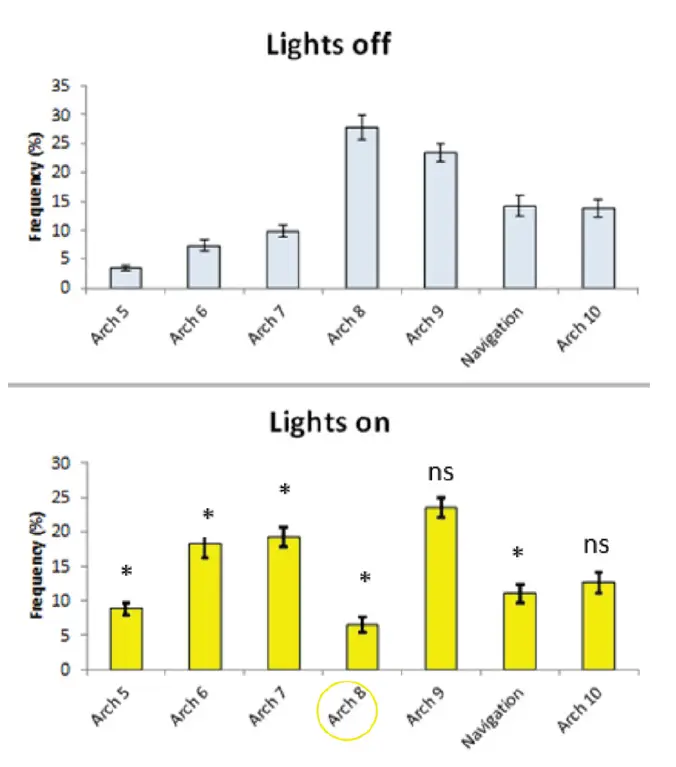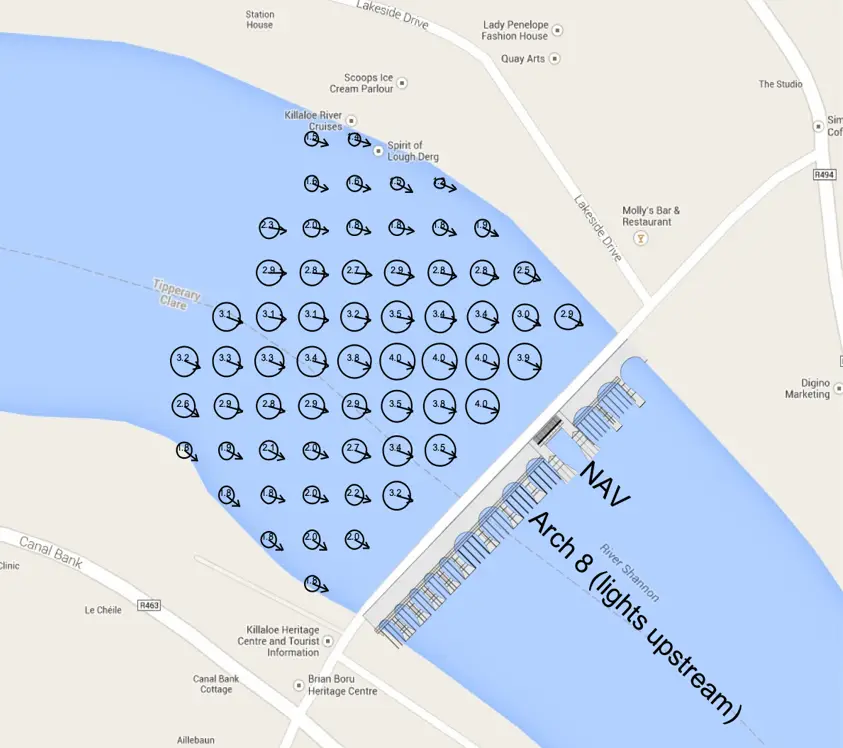Introduction
The River Shannon is Ireland’s longest river, at 361 km, with a mean annual flow of 186 m3s−1 at Killaloe. It’s located 3km upstream of the Ardnacrusha Hydroelectric Station, operated by Ireland’s Electricity Supply Board (ESB). The river supports a substantial seasonal downstream run of adult (silver) European eel (Anguilla Anguilla). ESB makes strenuous efforts each year to catch migrating adults via a trap-and-truck scheme operated at the Killaloe road bridge, then releasing them back into the river downstream of the power station.
Killaloe Bridge is a traditional stone-built bridge with multiple arches. Arches 5 to 11 (Figure 1) are fitted with hydraulically operated eel nets and the daily catch is monitored by the National University of Ireland, Galway. This provided an opportunity to test the efficacy of FGS’s HIL strobe light in November and December 2018, when an angled HIL array was installed and operated on Arch 8 only.
Figure 1

Schematic drawing of Killaloe eel weir seen from downstream. The arches fished and the arch with the light array is marked.
Methodology and Results
Catches for each of the individual bridge arches were recorded on selected nights with lights ON (n=19 nights) versus lights OFF control (n=16 nights). Catch data were recorded as eel biomass for each fished arch. The total eel biomass recorded amounted to 1531 kg (102 kg/night) for control nights across all fished arches and 934 kg for nights when HIL lights were operated (49.2 kg/night).
Figure 2

Figure 3

Length-frequency distributions of eels recorded in Arch 8 nets with HIL array On versus OFF
Individual catch records for Arch 8 trials indicate an average reduction in catch per night from 26.38 kg/night to 2.63 kg/night, i.e. a 90% reduction in biomass caught. Elevated catches in the adjacent bridge arches when the HIL array was ON suggest that operating the lights serves to divert eels from Arch 8 to the other unlit arches, with significant increases recorded for Arches 5, 6 & 7 (Lenihan & Lawton, 2019). Confirmation of this behaviour would require a more direct observational method such as tracking of individual eels fitted with acoustic tags or use hydroacoustic ‘daylight’ cameras such as ARIS or DIDSON.
Lenihan & Lawton (2019) also identified significant differences in the sizes of eels captured from Arch 8 versus Arch 9 when the lights were ON, whereas they reported no significant difference when the lights were off. This effect is also evident when size distributions of eels are compared for Arch 8 data for ON versus OFF nights in Figure 3. The pattern indicates that only smaller eels of <550 mm in length were passing when the light array was ON, no eels larger than this being caught. The implication is that larger eels, upon approaching the field of illumination, are able to navigate away and seek alternative passage routes, whereas smaller individuals may not have the swimming ability to avoid the lights. While no current speed measurements were taken during the period of observation, it is known that current velocities of up to 3-4 ms-1 can occur upstream of Killaloe Bridge (Figure 4), whereas the burst swimming speed of adult European eels in the 500-600 cm range has been estimated at <2 ms-1 (Clough et al., 2003) suggesting limited scope for avoidance.
Figure 4

Point measurements of velocity (ms-1) made during a previous study at Killaloe (details of river discharge at the time unspecified). (C. Lawton, pers. comm).
The findings indicate that any full-scale eel barrier designs here and elsewhere will need to take into account the expected velocity magnitudes during the migration season, positioning the HIL arrays far enough upstream to ensure sufficient scope for avoidance.
The results of the Killaloe trials indicate that in excess of 90% adult eel diversion is achievable using an HIL array.
References
Clough, S.C, Lee-Elliott, I.H., Turnpenny, A.W.H., Holden S.D.J., & Hinks, C. Environment Agency (2003). Swimming Speeds in Fish: phase 2. R&D Technical Report W2- 049/TR1.
Lenihan, E. and Lawton, C. (2019). The Use of Light Deflection to Deflect Eels at Killaloe Weir, River Shannon. Supplementary Report July 2019. Ryan Institute and School of Natural Sciences, National University of Ireland, Galway
Acknowledgements
Ryan Institute and School of Natural Sciences, National University of Ireland, Galway and the Electricity Supply Board, Ireland
We would like to acknowledge the contribution of Prof T. Kieran McCarthy, who sadly passed away on 13th March, 2019, having led the NUI Galway Eel Biology Programme for several years.